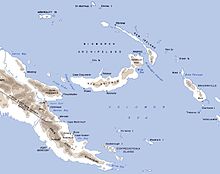
Back Batalla de Kaiapit Spanish Bataille de Kaiapit French Pertempuran Kaiapit ID Battle of Kaiapit SIMPLE
| Battle of Kaiapit | |||||||
|---|---|---|---|---|---|---|---|
| Part of the Markham and Ramu Valley – Finisterre Range campaign, World War II | |||||||
 Australian soldiers from the 2/16th Battalion arriving at Kaiapit on 20 September after the area was captured by the 2/6th Independent Company | |||||||
| |||||||
| Belligerents | |||||||
|
| |||||||
| Commanders and leaders | |||||||
|
|
| ||||||
| Strength | |||||||
| 226 | 500 | ||||||
| Casualties and losses | |||||||
| >214 killed | ||||||

The Battle of Kaiapit was an action fought in 1943 between Australian and Japanese forces in New Guinea during the Markham and Ramu Valley – Finisterre Range campaign of World War II. Following the landings at Nadzab and at Lae, the Allies attempted to exploit their success with an advance into the upper Markham Valley, starting with Kaiapit. The Japanese intended to use Kaiapit to threaten the Allied position at Nadzab, and to create a diversion to allow the Japanese garrison at Lae time to escape.
The Australian 2/6th Independent Company flew in to the Markham Valley from Port Moresby in 13 USAAF C-47 Dakotas, making a difficult landing on a rough airstrip. Unaware that a much larger Japanese force was also headed for Kaiapit, the company attacked the village on 19 September to secure the area so that it could be developed into an airfield. The company then held it against a strong counter-attack. During two days of fighting the Australians defeated a larger Japanese force while suffering relatively few losses.
The Australian victory at Kaiapit enabled the Australian 7th Division to be flown in to the upper Markham Valley. It accomplished the 7th Division's primary mission, for the Japanese could no longer threaten Lae or Nadzab, where a major airbase was being developed. The victory also led to the capture of the entire Ramu Valley, which provided new forward fighter airstrips for the air war against the Japanese.